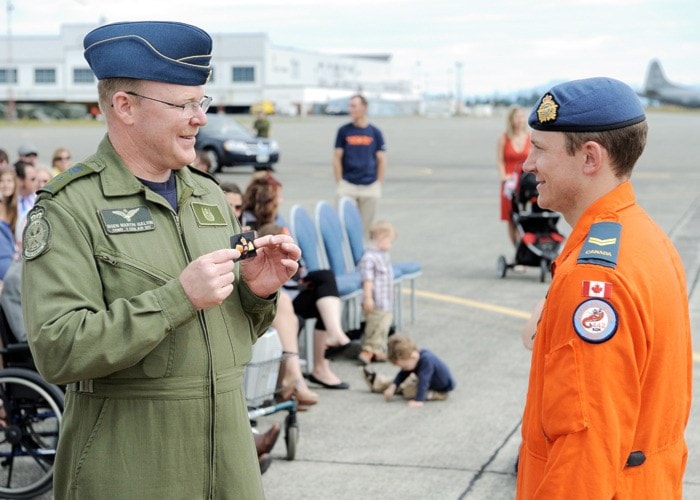COMOX — Following almost a year of some of the most intensive training in the Canadian Forces, Master Corporal Nelson’s Tyler Salmond has received his Search and Rescue Technician (SAR Tech) Wings and distinctive orange beret.
MCpl. Salmond joined the Canadian Forces in 2002 as an infantry soldier with the 3rd Battalion, Princess Patricia’s Canadian Light Infantry based in Edmonton. He served as a sniper in Afghanistan in 2009. Following his tour to Kandahar, he set out for a new challenge as a Search and Rescue Technician.
“I want to thank my family and friends for being so supportive along my journey to becoming a SAR tech,” said MCpl. Salmond.
The road to become a SAR Tech was not a short nor easy one. It started with a pre-selection process conducted in Edmonton and Jarvis Lake, Alberta. From a group of 31 hopefuls trying to become the next generation of SAR Techs, only eight actually became candidates on course. From there, the real challenge started.
“The most challenging portion of the course for me was the parachuting phase,” said MCpl. Salmond. “I had to get used to some new equipment and a different style of parachuting from when I used to do it in the army.”
MCpl. Salmond will now be posted to 442 Transport and Rescue Squadron in Comox.
SAR Tech training is run by the Canadian Forces School of Search and Rescue, located at 19 Wing, Canadian Forces Base Comox. The school prepares SAR Tech candidates to perform life saving missions throughout Canada, in some of the harshest weather and environmental conditions. Whether they are jumping into surf from a helicopter, rappelling down a cliff, parachuting into arctic winds or scuba diving into murky waters, SAR Techs are known for their ability to reach those in need.
“At the end of the selection phase I knew that I had a very strong group to work with. They arrived on course from a variety of backgrounds and jelled as a team very early,” said Sergeant Paul Moquin, senior instructor for SAR Tech Course 45. “Their dedication to the SAR Tech profession and to each other has been proven time and again and I am proud to say that I was their course ‘NCO’.”
Working with other Canadian SAR partners, the Canadian Forces plays a vital role in a world class SAR system that answers the call of those in need. The forces annually respond to approximately 8,000 incidents, tasking military aircraft or ships in about 1,100 cases. As primary care providers, SAR Techs travel on all military SAR aircraft.
The Canadian Forces’ responsibility for aeronautical and maritime SAR extends over 15 million square kilometres of land and sea — an area one-and-a-half times that of Canada’s landmass. The aeronautical SAR area extends from the US border to the North Pole, and from approximately 600 nautical miles (1,111 km) west of Vancouver Island in the Pacific Ocean to 900 nautical miles (1,667 km) east of Newfoundland in the Atlantic. The maritime SAR mandate includes the ocean waters within this area, as well as the St. Lawrence Seaway and the Great Lakes. SAR incidents under the federal SAR mandate are defined as “all aircraft incidents and all marine incidents in waters under federal jurisdiction.”
